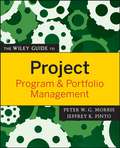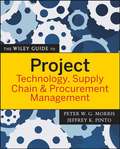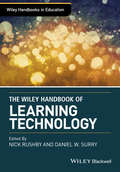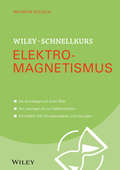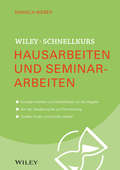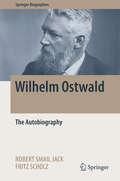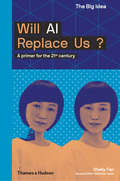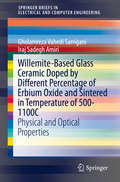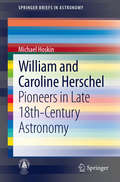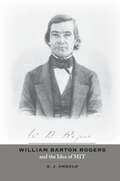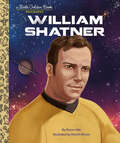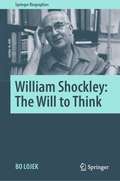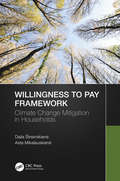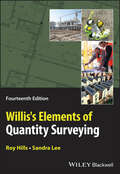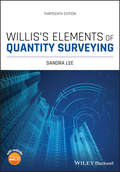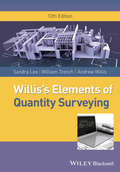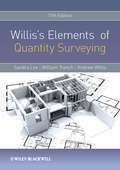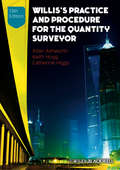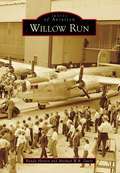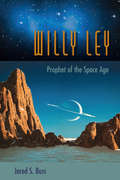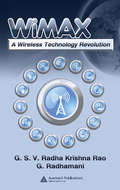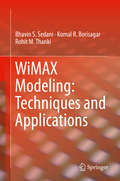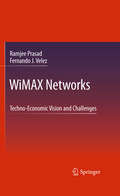- Table View
- List View
The Wiley Guide to Project, Program, and Portfolio Management (The Wiley Guides to the Management of Projects #10)
by Peter Morris Jeffrey K. PintoA comprehensive guide to project management and its interaction with other management systems and strategies The Wiley Guides to the Management of Projects address critical, need-to-know information that will enable professionals to successfully manage projects in most businesses and help students learn the best practices of the industry. They contain not only well-known and widely used basic project management practices but also the newest and most cutting-edge concepts in the broader theory and practice of managing projects. This first book in the series, The Wiley Guide to Project, Program & Portfolio Management, is based on the "meta" level of management, which, simply stated, asserts that project management must be integrated throughout an organization in order to achieve its full potential to enhance the bottom line. This book will show you how to fully understand and exploit the strategic management of projects, portfolios, and program management and their linkage with context and strategy in other concepts and processes, such as quality management, concurrent engineering, just-in-time delivery, systems management and engineering, teams, and statistical quality control. Featuring contributions from experts all around the world, this invaluable resource book offers authoritative project management applications for industry, service businesses, and government agencies. Complete your understanding of project management with these other books in The Wiley Guides to the Management of Projects series: * The Wiley Guide to Project Control * The Wiley Guide to Project Organization & Project Management Competencies * The Wiley Guide to Project Technology, Supply Chain & Procurement Management
The Wiley Guide to Project Technology, Supply Chain, and Procurement Management (The Wiley Guides to the Management of Projects #7)
by Peter W. G. Morris Jeffrey K. PintoA complete guide to managing technical issues and procuring third-party resources The Wiley Guides to the Management of Projects address critical, need-to-know information that will help professionals successfully manage projects in most businesses and help students learn the best practices of the industry. They contain not only well-known and widely used basic project management practices but also the newest and most cutting-edge concepts in the broader theory and practice of managing projects. This fourth volume in the series offers expert guidance on the supply chain and delivery cycle of the project, as well as the technology management issues that are involved such as modeling, design, and verification. Technology within the context of the management of projects involves not so much actually doing the "technical" elements of the project as managing the processes and practices by which projects are transformed from concepts into actual entities-and doing this effectively within the time, cost, strategic, and other constraints on the project. The contributors to this volume, among the most recognized international leaders in the field, guide you through the key life-cycle issues that define the project, ensure its viability, manage requirements, and track changes-highlighting the key steps along the way in transforming and realizing the technical definition of the project. Complete your understanding of project management with these other books in The Wiley Guides to the Management of Projects series: * The Wiley Guide to Project Control * The Wiley Guide to Project, Program & Portfolio Management * The Wiley Guide to Project Organization & Project Management Competencies
The Wiley Handbook of Learning Technology (Wiley Handbooks in Education)
by Nick Rushby Daniel W. SurryThe Wiley Handbook of Learning Technology is an authoritative and up-to-date survey of the fast-growing field of learning technology, from its foundational theories and practices to its challenges, trends, and future developments. Offers an examination of learning technology that is equal parts theoretical and practical, covering both the technology of learning and the use of technology in learning Individual chapters tackle timely and controversial subjects, such as gaming and simulation, security, lifelong learning, distance education, learning across educational settings, and the research agenda Designed to serve as a point of entry for learning technology novices, a comprehensive reference for scholars and researchers, and a practical guide for education and training practitioners Includes 29 original and comprehensively referenced essays written by leading experts in instructional and educational technology from around the world
Wiley-Schnellkurs Elektromagnetismus (Wiley Schnellkurs)
by Wilhelm KulischElektrizität und Magnetismus sind spannende Themen und deshalb lohnt es sich, sich hier einzulesen. Wilhelm Kulisch erklärt Ihnen knapp und verständlich, was Sie über Elektrizität und Magnetismus wissen sollten, ohne allzusehr ins Detail zu gehen. Er erläutert Ladungen, Spannung, elektrische Felder, elektrisches Potential, Induktion und Selbstinduktion und vieles mehr. Mit zahlreichen Übungsaufgaben samt Lösungen können Sie Ihr Wissen überprüfen und festigen.
Wiley-Schnellkurs Hausarbeiten und Seminararbeiten
by Daniela WeberMit dem Schreiben von Hausarbeiten kann man viel Zeit verbringen, muss man aber nicht unbedingt. Ein systematisches Vorgehen hilft hier ungemein viel Zeit zu sparen. Daniela Weber erklärt Ihnen in diesem Buch auf den Punkt und kompetent, wie Sie die Arbeit richtig gliedern, effektiv mit Quellen arbeiten, den Text verfassen und die Arbeit am Ende noch formatieren. So hilft Sie Ihnen, sich auf die wesentlichen Punkte der Arbeit zu konzentrieren und sich nicht lange mit Formalien aufzuhalten.
Wilhelm Ostwald
by Robert Smail Jack Fritz ScholzThis book is the translated and commented autobiography of Wilhelm Ostwald (1853-1932), who won the Nobel Prize for Chemistry in 1909. It is the first translation of the German original version "Lebenslinien: Eine Selbstbiographie," published by Ostwald in 1926/27, and has been painstakingly translated. The book includes comments and explanations, helping readers to understand Ostwald's text in the historical context of Germany at the beginning of the 20th century. In his autobiography, Ostwald describes his impressive research career and his life from his own personal view. Readers will find information on how Ostwald immortalized himself through his research on catalysis, chemical equilibria, technical chemistry, and especially as one of the founders of modern physical chemistry. His broad interests in science, ranging from philosophy to the theory of colors and the idea of a universal scientific language are further remarkable aspects covered. This work will appeal to a broad audience of contemporary scientists: Wilhelm Ostwald has been tremendously influential for the development of chemistry and science, and many of today's best-known international scientific schools can be traced back to Ostwald's students. Ostwald was active in Germany and what is now Latvia and Estonia, while also travelling to the USA, England and France. In his discussions and analyses of the working conditions of the time, readers will find many issues reflected that continue to be of relevance today.
Will AI Replace Us: A Primer For The 21st Century (The Big Idea Series #0)
by Shelly FanThis timely volume in The Big Idea series surveys the evolution of AI over the last sixty years and explores how it’s transforming society today and for decades to come. Artificial Intelligence, which once felt like a far-off futuristic fantasy, is now changing everyday life. The past sixty years have witnessed astonishing bursts of growth in the field of AI—the science and computational technologies that teach machines to sense, learn, reason, and act. AI is already altering our lives in ways that benefit health, productivity, and entertainment. Are we on the threshold of an AI-dominated world in which humans will no longer be necessary? Broken down into the past, present, and future of AI, Will AI Replace Us? gives the reader what they need to know in order to form an opinion about the revolutionary advances in technology. University of California, San Francisco, neuroscientist Dr. Shelly Fan expertly explains all sides of the debate, making the relevant science approachable for readers. Accompanying her intelligent text are numerous illustrations that add a compelling and informative visual element. Timely and relevant, Will AI Replace Us? is an important read in the Digital Age.
Willemite-Based Glass Ceramic Doped by Different Percentage of Erbium Oxide and Sintered in Temperature of 500-1100C: Physical and Optical Properties (SpringerBriefs in Electrical and Computer Engineering)
by Gholamreza Vahedi Sarrigani Iraj Sadegh AmiriThis book investigates the effect of sintering temperature on willemite based glass-ceramic doped with different content of Er2O3. It is the first to report research on producing willemite by using waste materials and using trivalent erbium (Er3+) as a dopant. This book provides a survey of the literature on glass and glass-ceramic, while comprehensive experiments and analysis have been performed on the material used.
William and Caroline Herschel
by Michael HoskinThis beautifully structured book presents the essentials of William and Caroline Herschel's pioneering achievements in late 18th-century astronomy. Michael Hoskin shows that William Herschel was the first observational cosmologist and one of the first observers to attack the sidereal universe beyond the solar system: Herschel built instruments far better than any being used at the royal observatory. Aided by his sister Caroline, he commenced a great systematic survey that led to his discovery of Uranus in 1781. Unlike observers before him, whose telescopes did not reveal them as astronomical objects, Herschel did not ignore misty patches of light. Hoskins points out Herschel's achievement in surveying, cataloguing, and describing them as "nebulae" and even coming to the correct conclusion that their structure evolved over time, with Newton's gravity being the agent of change. Herschel's surveys established a new astronomy - looking at the universe rather than the planets! Michael Hoskin's account includes sketches and diagrams from Herschel's manuscripts in the Royal Astronomical Society Archives in which he attempts to delineate the structure of the Milky Way galaxy. While it is well-known that Herschel was a revolutionary in telescope design who constructed the world's largest telescopes, Hoskin also gives the full picture of the man as an entrepreneur who built and traded some 400 telescopes. Hoskin also pays close attention to the role of William's sister Caroline Herschel, who is usually portrayed as a "helpmate" to her brother. But in fact she became a significant astronomer in her own right. This book also offers a wealth of information of the wider Herschel family. It is enriched by a complete set of portraits of William and Caroline Herschel with an extensive set of images of their residences and closes with a charming appendix on how visitors to the Herschels recorded their encounters. William and Caroline Herschel - Pioneers in Late 18th-Century Astronomy will appeal to amateur astronomers and all those interested in popular astronomy. This book will rapidly establish itself as the primary introductory work for students, astronomers, and scholars working on the history of natural science in the late 18th century.
William Barton Rogers and the Idea of MIT
by A. J. AnguloWinner, 2009 Outstanding Book Award, History of Education SocietyWinner, 2009 Richard Slatten Prize for Excellence in Virginia Biography, Virginia Historical SocietyConceptual founder of the Massachusetts Institute of Technology, William Barton Rogers was a highly influential scientific mind and educational reformer of the nineteenth century. A. J. Angulo recounts the largely unknown story of one man's ideas and how they gave way to the creation of one of America’s premier institutions of higher learning. MIT's long tradition of teaching, research, and technological innovation for real-world applications is inexorably linked to Rogers’ educational philosophy. Emphasizing the "useful arts"—a curriculum of specialized scientific study stressing theory and practice, innovation and functionality—Rogers sought to revolutionize standard educational practices of the day. Controversial in an era typified by a generalist approach to teaching the sciences, Rogers’ model is now widely emulated by institutions throughout the world. Exploring the intersection of Rogers' educational philosophy and the rise of technical institutes in America, this biography offers a long-overdue account of the man behind MIT.
William Shatner: A Little Golden Book Biography (Little Golden Book)
by Bruce HaleHelp your little one dream big with a Little Golden Book biography about William Shatner, the actor who explored new worlds on Star Trek. Little Golden Book biographies are the perfect introduction to nonfiction for young readers—as well as fans of all ages!This Little Golden Book about William Shatner--best known as Captain Kirk from Star Trek and the oldest person to travel to space in real life--is an inspiring read-aloud for young children, as well as their Trekkie parents and grandparents.Look for more Little Golden Book biographies: • Betty White • Carol Burnett • Lucille Ball • Harry Belafonte • Julie Andrews • Dwayne Johnson
William Shockley: The Will to Think (Springer Biographies)
by Bo LojekThis book takes a fresh look at the work, thoughts, and life of 1956 Nobel Prize winner William B. Shockley. It reconstructs Shockley’s upbringing, his patriotic achievements during World War II, his contribution to semiconductor physics – culminating with the epoch-making invention of the transistor – and his views on the social issues of his time. The author’s unparalleled access to Shockley’s personal documents provides insight into a colorful, yet controversial, man, and also sheds light on the attitudes of other prominent scientists of that era. Shockley was not only an outstanding scientist in his own right but also a fiercely independent thinker in perpetual search of the truth. His contributions to the field known today as microelectronics are enormous and unmatched. This book explores the critical facets of Shockley’s life, replete with never-before-published photos and excerpts from his private correspondence and personal notebooks. The book also delves into Shockley’s views on genetics and human intelligence. It tells the story of a man beset by an unrelenting rationality, slandered by the popular media, and ultimately alienated by his peers. It discusses his controversial, although sometimes prescient, ideas regarding human genetics, putting these into the context of modern research findings. Today, William Shockley is perhaps just as enigmatic as his work and accomplishments. The author presents a convincing argument that Shockley still has much to say about the issues of our age, and many of his ideas deserve evaluation in the public forum.
William's Windmills (Fountas & Pinnell LLI Red #Level M)
by Susan Ring Terry ShannonThe story of William Kankwamba shows how a boy's determination brought light to his home and inspired people all over the world.
Willingness to Pay Framework: Climate Change Mitigation in Households
by Dalia Štreimikienė Asta MikalauskienėThis book aims to develop a framework for the assessment of population ‘preferences in climate change mitigation policies by applying a Willingness to Pay (WTP) approach and presents the results from several case studies in Lithuania on renewable energy generation and renovation in different households. These analyses of climate change mitigation policies and measures, based on the assessment of their effectiveness, provide recommendations for developing innovative measures in other countries. Since public preferences are variable, climate change mitigation policies can change these preferences and allow to form new ones. Features: Analyses social benefits of climate change mitigation measures and their integration methods based on assessment of public preferences. Presents several practical case studies on energy needs where the Willingness to Pay framework was applied. Discusses climate change mitigation barriers in energy sector and the effectiveness of climate change mitigation policies to overcome them. Provides a novel approach for climate change mitigation policies development in households. Includes useful information for evaluating and planning policies related to renewable energy investment. This book is a useful reference for those in the academic, research, and business communities, policy makers, graduate students, and professionals involved with climate change mitigation projects.
Willis's Elements of Quantity Surveying
by Roy Hills Sandra LeeWillis’s Elements of Quantity Surveying A fully-updated new edition of the classic quantity surveyor’s guide Quantity Surveying (QS) involves the practice and management of costs related to building and civil engineering projects. Built on the fundamental skill of measuring building quantities, QS practitioners offer a range of services including cost assessments for life cycles, reducing carbon emissions, and more. For almost ninety years, Willis’s Elements of Quantity Surveying has been the indispensable introduction to the theory and practice of quantity surveying. Now updated to reflect the latest standards and practices, it promises to train a new generation of skilled contributors to the building and engineering trades. Readers of the fourteenth edition of Willis’s Elements of Quantity Surveying will also find: New chapter on measuring electrical works Companion website with videos and worked-through examples for instructors Updates reflecting the 2021 edition of the Royal Institution of Chartered Surveyors’ New Rules of Measurement 2 Willis’s Elements of Quantity Surveying is ideal for all undergraduate students in quantity surveying and related construction disciplines.
Willis's Elements of Quantity Surveying
by Sandra LeeWillis’s Elements of Quantity Surveying has become a standard text in the teaching of building measurement – a core part of the degree curriculum for quantity surveyors. The book will be fully updated to follow the guidance given by RICS NRM 1 & 2. As in previous editions the focus remains a logical approach the detailed measurement of building elements and copious use of examples to guide the student. The text has been fully revised in line with the NRM guidance and includes many new and revised examples illustrating the use of NRM. The hallmarks of previous editions – clarity and practicality – are maintained, while ensuring the book is fully up to date, providing the student of quantity surveying with a first class introduction to the measurement of building elements.
Willis's Elements of Quantity Surveying
by Sandra Lee William Trench Andrew WillisThe measurement of building elements is a core subject for quantity surveying students. Responding to the recently published second volume of the New Rules of Measurement (NRM2) by the Royal Institution of Chartered Surveyors, the 12th edition of Willis's Elements of Quantity Surveying explains, from first principles and to NRM2 standards, the measurement process for all the key building elements. This edition begins with an overview of the need for measurement and the differing rules governing measurement at different stages of the design or project cycle. As in previous editions the focus remains the detailed measurement of building elements, but the text has been fully revised in line with the NRM2 rules. A range of new and revised examples illustrating the use of NRM2 rules are a key feature of the book, which concludes with guidance on how to use the data collected during the measurement process to create the tender documents. In the 12th edition the hallmarks of previous editions – clarity and practicality – have been maintained while ensuring the book is fully up to date, providing the student of quantity surveying with a first class introduction to the measurement of building elements.
Willis's Elements of Quantity Surveying
by Sandra Lee William Trench Andrew WillisWillis's Elements of Quantity Surveying has become a standard text in the teaching of building measurement – a core part of the curriculum for quantity surveyors. Particularly in the latter editions it has eclipsed the other books on building measurement, partly because of the heritage, but mostly because of the logical approach and copious use of examples to guide the student. The new 11th edition has been fully updated to recognise the introduction of the New Rules of Measurement (NRM) by the Royal Institution of Chartered Surveyors (RICS), which reflect the way the modern QS works and provide a standard set of measurement rules that are understandable by all those involved in a construction project. Key features: First published in 1935, has been used by many generations of quantity surveyors and lecturers New edition fully updated to include the RICS new rules of measurement (NRM) Many examples updated to reflect current QS practice Revisers have extensive experience of teaching the subject through College of Estate Management courses
Willis's Practice and Procedure for the Quantity Surveyor
by Allan Ashworth Catherine HiggsWILLIS’S PRACTICE AND PROCEDURE FOR THE QUANTITY SURVEYOR The most up-to-date edition of the gold standard in introductory quantity surveying textbooks In the newly revised Fourteenth Edition of Willis’s Practice and Procedure for the Quantity Surveyor, the authors provide a comprehensive and authoritative introduction to the core skills required by quantity surveyors. This latest edition is thoroughly updated to emphasize the use of information technology in construction, and contains new pedagogical features, new learning outcomes, and key learning points that relate the material specifically to the RICS Assessment of Professional Competence (APC). Historically employed to estimate and measure the likely material requirements for any building project, the role of the modern quantity surveyor is diverse and dynamic, with rapid change featuring across quantity surveying practice. The book echoes this dynamic environment, covering quantity surveying in private practice, public service, and in contracting organizations. Readers will also find: In-depth discussions of the use of IT in construction New and improved teaching and instruction features in the text, including new learning outcome sections and key learning points to highlight crucial concepts Tighter alignment with the requirements of the RICS Assessment of Professional Competence Perfect for undergraduate students studying quantity surveying, Willis’s Practice and Procedure for the Quantity Surveyor, 14th Edition is also an indispensable resource for practicing surveyors and inspectors seeking a one-stop handbook to the foundational principles of quantity surveying.
Willis's Practice and Procedure for the Quantity Surveyor
by Allan Ashworth Keith Hogg Catherine HiggsHistorically employed to estimate and measure the likely material requirements for any building project, the role of the modern quantity surveyor is diverse, with a wide range of employers and geographical locations to match. Change continues to be a feature in quantity surveying practice, with the New Rules of Measurement, the RICS Black Book and Building Information Modelling (BIM) all adding to the already dynamic environment in which the Quantity Surveyor operates. This new edition of Practice and Procedure for the Quantity Surveyor reflects that dynamic environment, addressing changing practices and procedures in the profession, whilst focussing on the core skills which are essential to success. The 13th edition of this classic text, originally written by three generations of the Willis family (all quantity surveyors) continues to provide a thorough introduction to the work of the quantity surveyor in private practice, in public service and in contracting organisations.
Willow Run (Images of Aviation)
by Michael W.R. Davis Randy HottonIn May 1940, Pres. Franklin D. Roosevelt called for the production of 50,000 military airplanes. He then drafted the president of General Motors, William Knudsen, to mobilize industry in the United States. The automotive companies were called upon to produce a massive fleet of bombers, as well as tanks, trucks, guns, and engines. By the Willow Run, a sleepy little creek near Ypsilanti, Michigan, Ford Motor Company built the world's most famous bomber factory, which was the ultimate manifestation of the automotive industry's role in building armaments during World War II. By the spring of 1944, Willow Run was producing a four-engine B-24 bomber each hour on an assembly line. With tremendous assistance from the Yankee Air Museum, this book presents a pictorial history of Willow Run during World War II.
Willy Ley: Prophet of the Space Age
by Jared S. Buss"Beautifully written. Reveals the vicissitudes of an extraordinarily interesting life."--Michael J. Neufeld, author of Von Braun: Dreamer of Space, Engineer of War "Willy Ley has been a mystery among spaceflight historians for many years. His role as science writer, advocate, and popularizer is known to many but understood by few. This book unpacks that story."--Roger D. Launius, associate director of collections and curatorial affairs, National Air and Space Museum "Ley lit the fire of interplanetary enthusiasm in the hearts of generations of young space cadets. Long overdue, this biography establishes the details and the ups and downs of his career."--Tom D. Crouch, author of Lighter Than Air: An Illustrated History of Balloons and Airships "Beyond recovering the fascinating and many contradictory aspects of Ley's extraordinary life, Buss has provided a valuable case study of the complex relationship between science popularization, mass media, and scientific advocacy in the twentieth century."--Asif A. Siddiqi, author of The Red Rockets' Glare: Spaceflight and the Soviet Imagination, 1857-1957 Willy Ley inspired young rocket scientists and would-be astronauts around the world to imagine a future of interplanetary travel long before space shuttles existed. This is the first biography of the science writer and rocketeer who predicted and boosted the rise of the Space Age. Born in Germany, Ley became involved in amateur rocketry until the field was taken over by the Nazis. He fled to America, where he forged a new life as a weapons expert and journalist during World War II and as a rocket researcher after the war. As America's foremost authority on rockets, missiles, and space travel, he authored books and scientific articles, while also regularly writing for science fiction pulp magazines and publishing what he termed romantic zoology--a blend of zoology, cryptozoology, history, and mythology. He even consulted for television's Tom Corbett, Space Cadet and the Disney program Man in Space, thrilling audiences with a romanticized view of what spaceflight would be like. Yet as astronauts took center stage and scientific intellectuals such as Wernher von Braun became influential during the space race, Ley lost his celebrity status. With an old-fashioned style of popular writing and eccentric perspectives influenced by romanticism and science fiction, he was ignored by younger historians. This book returns Willy Ley to his rightful place as the energizer of an era--a time when scientists and science popularizers mixed ranks and shared the spotlight so that our far-fetched, fantastic dreams could turn into the reality of tomorrow. Jared S. Buss is adjunct professor of history at Oklahoma City Community College.
WiMAX: A Wireless Technology Revolution
by G. Radhamani G.S.V. Radha RaoExamining the technology's global development and deployment activities, WiMAX: A Wireless Technology Revolution presents its unique features and evaluates its revolutionary approach. The book covers the mission, product, and services of WiMAX, as well as specific features such as security and mobility. It discusses the implementation of the IEEE 802.16 standard and also explores how WiMax stacks up to 3G and 4G and the economic and opportunity costs. This reference also analyzes the future prospects of WiMAX and its contribution to the wireless and mobile communication technology field. It is a must-have resource for those who are either intrigued or involved with this standards-based technology.
WiMAX Modeling: Techniques and Applications
by Rohit M. Thanki Komal R. Borisagar Bhavin S. SedaniThis book provides information about wireless systems and WIMAX modeling. The authors provide various techniques for the WiMAX systems such as antenna diversity and Alamouti coding. The performance of these systems is tested using various types of data and the results of systems are presented and discussed. Additional topics include WiMAX simulation using diversity techniques and real time WiMAX system modeling. The book pertains to researchers, academics, students, and professionals.Provides information about wireless system modeling and WiMAX systems;Presents WiMAX system modeling using antenna diversity techniques and the Alamouti coding scheme;Includes real time WiMAX system modeling for speech signal and digital images.
WiMAX Networks
by Fernando J. Velez Ramjee PrasadIgnited by the mobile phone's huge success at the end of last century, the demand for wireless services is constantly growing. To face this demand, wireless systems have been and are deployed at a large scale. These include mobility-oriented technologies such as GPRS, CDMA or UMTS, and Local Area Network-oriented technologies such as WiFi. WiMAX Networks covers aspects of WiMAX quality of service (QoS), security, mobility, radio resource management, multiple input multiple output antenna, planning, cost/revenue optimization, physical layer, medium access control (MAC) layer, network layer, and so on.
